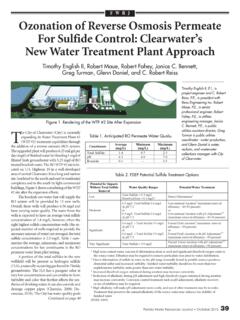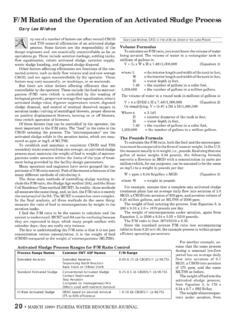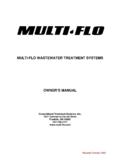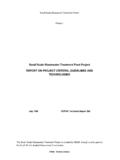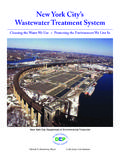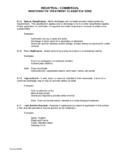Transcription of Domestic Wastewater Treatment Plants In Florida …
1 Domestic Wastewater Treatment Plants In Florida David York and Elsa Potts omestic Wastewater manage- Cummulative %. ment in Florida can be charac- 100. terized by a multitude of small facilities, and by a small num- 80. ber of large facilities that represent the majority of the total permitted capacity in 60. the state. Based on a 1993 review of DEP. records, there are about 3,500 permitted, 40. Domestic Wastewater Treatment facilities in Florida . The total permitted capacity of these 20. facilities is about 2,180 mgd. The predominance of small package treat- ment facilities is striking. Figure 1 presents 0. the distribution of the 3,500 Domestic waste- 1 10 100.
2 Water Treatment facilities by size. The dis- Plant Capacity (mgd). tribution of permitted capacities of these Figure 1. Facilities in 1993 Number of WWTPs Capacity (mgd). facilities also is shown in Figure 1. About 80. percent of Florida 's Treatment facilities have capacities less than mgd. However, these small facilities Obviously, the larger facilities in Florida contribute the vast account for only about three percent of the total permitted majority of the state's permitted capacity. Domestic wastewa- capacity in the state. There are slightly more than 3,200 ter Treatment facilities over mgd constitute less than 3. Domestic Wastewater Treatment facilities having capacities percent of the state's facilities but they represent about 70.
3 Less than mgd (about 92 percent of the total number of percent of the total permitted capacity. There are 42 facilities facilities). Facilities less than mgd account for only about having permitted capacities of 10 mgd or more. These 42. 10 percent of the total permitted capacity in Florida . facilities represent only about percent of the total number Table 1. Florida 's Largest Treatment Facilities in 1993. Level of Capacity Primary Reuse/. Treatment Facility County Treatment (mgd) Disposal Method Miami-Dade-Central District Dade Secondary Ocean Outfall Miami-Dade-North District Dade Secondary Ocean Outfall Tampa-Hookers Point Hillsborough AWT (a) Surface Water Broward County-North Broward Secondary Ocean Outfall Miami-Dade-South District Dade Secondary Deep Wells Jacksonville-Buckman St.
4 Duval Secondary Surface Water Hollywood Broward Secondary Ocean Outfall Orlando-Iron Bridge Seminole AWT(a) Reuse (Wetlands) & Surface Water West Palm Beach-East Central Palm Beach Secondary Deep Wells Ft. Lohmeyer Broward Secondary Deep Wells Bay County Regional Bay Secondary Surface Water Port St. Joe Gulf Secondary Surface Water Orange County-Sand Lake Rd. Orange Secondary(a) Reuse (Conserv-II). Smith Leon Secondary Reuse (Spray Irrigation). Orlando-McLeod Rd. Orange Secondary(a) Reuse (Conserv-II). Pinellas County-South Cross Bayou Pinellas Secondary Deep Wells Boynton-Delray-South Central Palm Beach Secondary Ocean Outfall Pensacola-Main Street Escambia AWT Surface Water St.
5 Petersburg-Northwest Pinellas Secondary(a) Reuse St. Petersburg-Southwest Pinellas Secondary(a) Reuse Orange County-Easterly Orange AWT Wetlands & Reuse Manatee County-Southwest Manatee Secondary(a) Reuse Boca Raton Palm Beach Secondary Ocean Outfall & Reuse St. Petersburg-Northeast Pinellas Secondary(a) Reuse Largo Pinellas AWT(a) Reuse Palm Beach County-Southern Region Palm Beach Secondary Deep Wells & Reuse Reedy Creek Improvement District Orange AWT(a) Reuse Total Notes: (a) Provides High-level disinfection. (b) Source: 1993 DEP data. JANUARY 1995 Florida WATER RESOURCES JOURNAL 31. of facilities, yet their capacities (about 1,240 Cummulative %.)
6 Mgd) represent about 57 percent of the 100. state total. Table 1 lists the 27 largest facilities in Florida (having capacities of at 80. least 15 mgd), which account for less than 1. percent of the number of facilities and about 60. 50 percent of capacity. While these large facilities are very important to Domestic Wastewater management in Florida , they 40. are relatively small in comparison to the largest facilities in several of the nation's 20. metropolitan areas, the largest of which have capacities over 1,000 mgd. 0. 1 10 100. Implications for Reuse Plant Capacity (mgd). Sections and , Florida Stat- utes ( ), establish the encouragement Figure 2.
7 Facilities in 1966 Number of WWTPs Capacity (mgd). and promotion of reuse of reclaimed water as formal state objectives. Reflecting these objectives, the DEP lowering of this minimum system size requirement to and the water management districts have implemented a mgd.) These size constraints eliminate several of the most reuse program. In response to state program and other factors, attractive reuse activities from consideration by owners of the reuse continues to grow in popularity in Florida . The 1992 vast majority of Domestic Wastewater facilities in the state of Reuse Inventory (DER, 1992) identified nearly 300 reuse projects Florida . Recognizing these constraints, the 1994 Florida Leg- using about 300 mgd of reclaimed water for beneficial pur- islature exempted facilities heaving capacities less than poses.
8 Projects included in the 1992 inventory had reuse mgd from the reuse feasibility study requirements in Section capacities totaling about 600 mgd, which is about 30 percent , of the state's total permitted capacity for all Domestic waste- As noted previously, the large facilities in Florida account water Treatment facilities. Reuse has become an important for a large percentage of the state's total permitted capacity. To part of Wastewater management in Florida . achieve a significant increase in the level of reuse in Florida , Inspection of Table 1 reveals that a number of Florida 's additional reuse activity will be needed from the larger facili- largest facilities have implemented reuse.
9 However, several of ties. Unfortunately, several of the very large facilities face the largest facilities, which are located in designated Water difficulties in converting to reuse. Some facilities located near Resource Caution Areas (formerly known as Critical Water the coast experience infiltration of brackish water into the Supply Problem Areas), continue to rely on disposal methods collection system. This results in increased salinity in the such as ocean outfalls, other surface water discharges, and reclaimed water, which may significantly reduce the potential deep well injection. Several of these facilities are beginning to use for landscape or agricultural irrigation.
10 Frequently, the implement reuse for a portion of their flows. Of note is the City larger facilities are located near the coast. Transmission of of Tampa's proposed, large-scale, indirect potable reuse project. reclaimed water back across miles of heavily developed infra- Treatment facilities having capacities less than mgd structure to reach developing residential areas and agricul- currently are precluded by Chapter 62-610, Florida Adminis- tural areas greatly adds to the cost of reuse conversion. For trative Code, from implementing any form of public access facilities in the to range, golf courses, which reuse. This chapter also eliminates the possibility of residen- typically use about mgd, can be important parts of the reuse tial irrigation or irrigation of edible food crops using reclaimed system.

